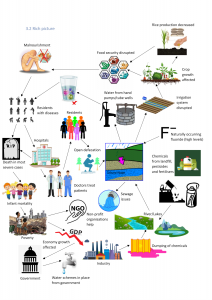This case study by Neil McBride from DMU’s Centre for Computing and Social Responsibility looks at Sustainable Development Goal (SDG) Awareness through Systems Thinking…..
 Through what DMU course are you teaching about sustainability and the SDGs?
Through what DMU course are you teaching about sustainability and the SDGs?
IMAT2421 is a second-year module taught to cohorts of 50-60 business computing students in the faculty of Computing Engineering and Media (CEM). Students are exposed to the concepts and ideas of systems and systems thinking. We explore concepts of boundary, hierarchy and emergence. We examine natural, designed and social systems. The ideas of Systems Dynamics are explored and we seek to understand feedback loops through the development of causal loop maps. At the heart of the module is the study of the Soft Systems Methodology, which enables us to understand wicked problems and social systems (see image for an example ‘Rich Picture’ using this approach).
What have you done to make sustainable development issues part of this course?
Systems thinking, in which we acknowledge complexities and look for networks of causal links in order to understand problems holistically, is a core competency required for SDG education (see Commonwealth Secretariat (2017) A Curriculum Framework for Sustainable Development Goals), so it was natural that the assessment of the students’ grasp of systems thinking concepts, methods and tools should be founded on SDGs. As such it also provided an opportunity to expand the field of view of computing students outside the narrow confines of business computing. Hence, I made the SDGs the central plank of the assignment rather than an add-on.
Students are required to read up on SDGs and select their own case study to base a systems thinking analysis on. The output requires presentation of causal maps, a rich picture, and iceberg model and an impact gaps canvas (a ‘Map the System‘ tool) as the basis for the system thinking investigation of an SDG related problem. Student’s employ a range of diagrams and are only permitted 500 words of supporting text. The complex interactions systems thinking depicts and analyses require diagrams and is primarily based on visual representation.
To find an appropriate case study, students are required to take a top-down approach, starting by choosing an SDG tile, reading the overview, then selecting a target and its indicators and reading about progress. Based on this understanding, students search for a suitable case study, considering systems concepts of boundaries and hierarchies. Hence students make connections between the high-level information on SDGs and something on the ground, say soil erosion in a village in Bangladesh.
How does this teaching and learning activity relate to your research, professional background or other DMU activities?
I was formally a director of the UK System Society. I have published on systems thinking in a major systems studies journal and practiced the techniques in consultancy. Beyond the practice, it connects with my research on Information and Communication Technology (ICT) in developing countries, most recently concerning the impact of mobile money on rural poverty in Western Kenya (see here). I have been an educator for two years supporting De Montfort’s entry in Map the System, the concepts and tools of which I have fed back into IMAT2421. I have also taught on De Montfort University’s CPD Systems Thinking workshop.
How do students benefit from having this focus on sustainability within their course?
The assignment roots sustainability in the students’ thinking, introduces an awareness of SDGs which I hope sticks with them, and expands the students’ interest in environmental issues, poverty issues and education. It exposes them to different worldviews.
The module as an application of systems thinking requires a change in mindset, an exploration beyond their narrow disciplinary boundaries. This doesn’t go down well, and has in the past resulted in complaints to staff student liaison meetings: why are we studying sea urchin development, car engines and schools? Why do I have to find an SDG? How is this relevant to programming? One has to then patiently wait for the penny to drop, which it frequently does, though this can be a couple of years down the line when I receive an email about the influence of the systems thinking module on a student’s employment. I think my greatest accolade was a few years back when a student burst into my office with a flurry of insightful questions, saying ‘this is doing my brain in’. Yes, that’s exactly what it’s supposed to do!
What would you recommend to colleagues considering adopting a similar approach?
Exploring sustainability through SDGs can be a part of many modules which require the assessment of the practice of analytical techniques whether in business, humanities or engineering. Underpinning an assessment with case studies drawn from SDGs can not only provide a platform for their creative practice, but also introduce the student to SDGs and expand their horizons into the field of sustainability. Taking a top-down approach where the student is required to explore tiles, targets and progress in SDGs also exposes the student to the concepts and overall approach of SDGs. Requiring the student to find their own case study following a drill-down into SDGs increases engagement and ownership as the student’s eyes are opened to the particular complexity and diversity of the issues in their selected case study.
As far as Systems Thinking is concerned, the concepts can be fruitfully applied across many disciplines. Our 2020 Map the System finalist applied them to understand the complexities of the fashion industry and the resulting effect on modern slavery.
Please do contact me by email if you would like access to the IMAT2421 material.
